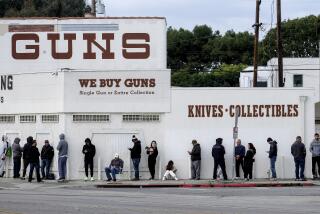COLUMN LEFT : Investments in Making Peace Work : The lion’s share of the dividend should go to six major areas of national need.
- Share via
The inevitability of defense cuts makes it especially imperative that we Californians, with an economy so heavily dependent on defense industries, think seriously about how we can make peace work for us.
How big a peace dividend will there be? After carefully studying the analyses of a number of respected experts--including the Congressional Budget Office and the Brookings Institution--I have concluded that we can safely cut military spending 33% below its present level by 1997, and accumulate a peace dividend of $375 billion in the process.
Properly invested, this peace dividend could open up lucrative markets for new and existing commercial products, create thousands of new jobs and businesses and boost the productivity of the American worker. The resultant expansion in the nation’s economy would help cut the federal deficit through increased federal revenues and reduced outlays for such things as welfare and unemployment compensation.
But I propose that no more than 5% to 10% of the peace dividend go directly into deficit reduction, and that none of it be used as an excuse to cut taxes. We have too much work to do. Instead, the lion’s share should be invested in six major areas of national need:
* $60 billion to help upgrade education and overcome illiteracy.
Productivity is directly related to education. America cannot compete in the world economy with a work force that can’t read or write or is unschooled in math and science.
Investing in teachers and in model math and science instruction will expand the need for learning-technology products.
* $123 billion to modernize the nation’s infrastructure.
Repair rutted highways and collapsing bridges, build ports and airports, and develop the rapid transit systems we need if our people and our products are not to strangle in gridlock.
Investing in transportation would generate new demand and new markets for computerized traffic-monitoring systems, new materials for lighter-weight bridges, magnetically levitated trains, quieter aircraft and smarter cars.
Transportation costs are a sizable component of the price of goods and services for domestic consumption and for export. The reliability and efficiency of our transportation facilities are keys to increased economic activity.
* $62 billion more to clean up toxic waste, accelerate pollution control and enforce pollution prevention.
The longer we delay cleaning up our land, air and water--and developing non-toxic ways of doing business--the greater will be the ultimate cost in health and in dollars.
Investing in environmental cleanup could lead to developing crops that are more resistant to pests and to microorganisms that eat pollutants. It would spur new technologies to neutralize the toxics we’ve already spewed out and avoid future crises.
* $61 billion to alleviate the lack of affordable housing that afflicts the poor and the middle class alike, and renew our nation’s historic commitment to good housing.
Investing in housing would be a boon to business in a number of ways: It would stimulate advances in new materials, such as composites, and encourage innovations for better living--new heat exchange and air-circulation equipment, simplified wiring, more automation.
Affordable housing closer to where people work would make for a more productive work force by reduce absenteeism and “commuter fatigue.”
* $53 billion to improve the nation’s health care.
Investing in health can lead to a new generation of biotechnology-based therapeutics to stimulate the body’s own repair and immune mechanisms; new diagnostics to detect diseases earlier; new therapies to treat mental illness, cancer, anemia, Alzheimer’s disease, AIDS and other ailments, and new technologies for elderly people and the disabled, such as voice-operated computers that read, write and talk.
* $15 billion more for treatment, prevention and law enforcement in the underfunded fight against crime and drugs.
Investing in the fight against drugs and crime will add to the demand for new computer and laser technologies, many of which also have consumer uses. A victory in the war against drugs will give us two indispensable assets for a productive economy--safe communities and a drug-free work force.
More to Read
Get the L.A. Times Politics newsletter
Deeply reported insights into legislation, politics and policy from Sacramento, Washington and beyond. In your inbox twice per week.
You may occasionally receive promotional content from the Los Angeles Times.










